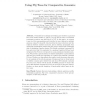Free Online Productivity Tools
i2Speak
i2Symbol
i2OCR
iTex2Img
iWeb2Print
iWeb2Shot
i2Type
iPdf2Split
iPdf2Merge
i2Bopomofo
i2Arabic
i2Style
i2Image
i2PDF
iLatex2Rtf
Sci2ools
CPM
2005
Springer
2005
Springer
Using PQ Trees for Comparative Genomics
Permutations on strings representing gene clusters on genomes have been studied earlier in [18, 14, 3, 12, 17] and the idea of a maximal permutation pattern was introduced in [12]. In this paper, we present a new tool for representation and detection of gene clusters in multiple genomes, using PQ trees [6]: this describes the inner structure and the relations between clusters succinctly, aids in filtering meaningful from apparently meaningless clusters and also gives a natural and meaningful way of visualizing complex clusters. We identify a minimal consensus PQ tree and prove that it is equivalent to a maximal πpattern [12] and each subgraph of the PQ tree corresponds to a non-maximal permutation pattern. We present a general scheme to handle multiplicity in permutations and also give a linear time algorithm to construct the minimal consensus PQ tree. Further, we demonstrate the results on whole genome data sets. In our analysis of the whole genomes of human and rat we found about
| Added | 26 Jun 2010 |
| Updated | 26 Jun 2010 |
| Type | Conference |
| Year | 2005 |
| Where | CPM |
| Authors | Gad M. Landau, Laxmi Parida, Oren Weimann |
Comments (0)

